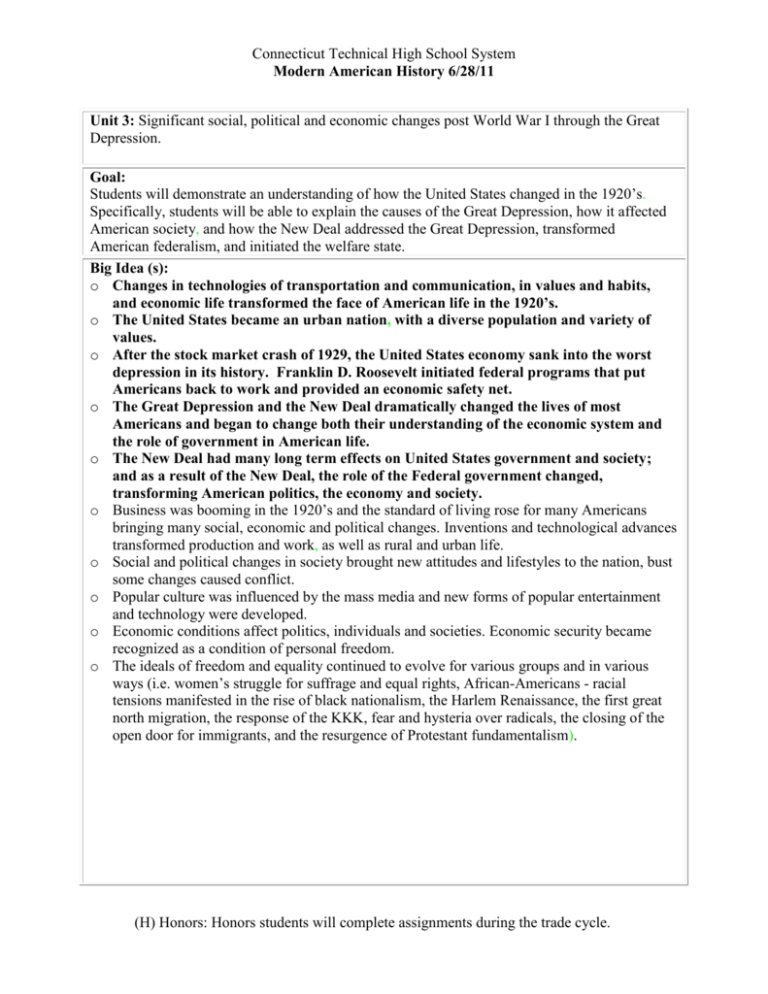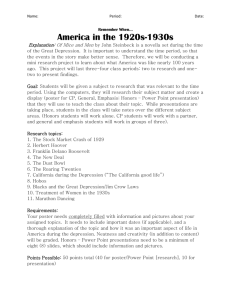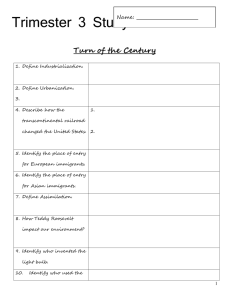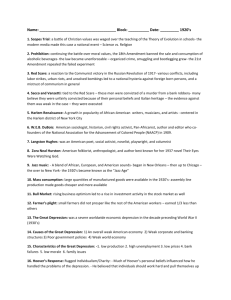Unit: The 1920`s, Great Depression and the New Deal
advertisement

Connecticut Technical High School System Modern American History 6/28/11 Unit 3: Significant social, political and economic changes post World War I through the Great Depression. Goal: Students will demonstrate an understanding of how the United States changed in the 1920’s. Specifically, students will be able to explain the causes of the Great Depression, how it affected American society, and how the New Deal addressed the Great Depression, transformed American federalism, and initiated the welfare state. Big Idea (s): o Changes in technologies of transportation and communication, in values and habits, and economic life transformed the face of American life in the 1920’s. o The United States became an urban nation, with a diverse population and variety of values. o After the stock market crash of 1929, the United States economy sank into the worst depression in its history. Franklin D. Roosevelt initiated federal programs that put Americans back to work and provided an economic safety net. o The Great Depression and the New Deal dramatically changed the lives of most Americans and began to change both their understanding of the economic system and the role of government in American life. o The New Deal had many long term effects on United States government and society; and as a result of the New Deal, the role of the Federal government changed, transforming American politics, the economy and society. o Business was booming in the 1920’s and the standard of living rose for many Americans bringing many social, economic and political changes. Inventions and technological advances transformed production and work, as well as rural and urban life. o Social and political changes in society brought new attitudes and lifestyles to the nation, bust some changes caused conflict. o Popular culture was influenced by the mass media and new forms of popular entertainment and technology were developed. o Economic conditions affect politics, individuals and societies. Economic security became recognized as a condition of personal freedom. o The ideals of freedom and equality continued to evolve for various groups and in various ways (i.e. women’s struggle for suffrage and equal rights, African-Americans - racial tensions manifested in the rise of black nationalism, the Harlem Renaissance, the first great north migration, the response of the KKK, fear and hysteria over radicals, the closing of the open door for immigrants, and the resurgence of Protestant fundamentalism). (H) Honors: Honors students will complete assignments during the trade cycle. Connecticut Technical High School System Modern American History 6/28/11 Essential Question (s): 1920’s o How and why did technology and American society change during the twenties? o Why did problems develop in the American economy in the 1920’s? o What were the ideas and issues that made the 1920’s “roar”? o Is what is good for American business good for America? o How can leadership affect a nation? Great Depression o How did the American view of government and the economy change during the Great Depression? o How does the economy affect politics? o What forces drive an economy? When these forces fail, what impact does it have on individuals and societies? New Deal o What long term effects did the New Deal have on American politics, economy, and society? o What should the role of government be in meeting the needs of its citizens? o Does regulating the economy infringe upon individual freedom? Learning Outcomes Students will: Literacy 1. Define and apply key vocabulary/concepts: Red Scare, “Lost Generation”, Prohibition, Harlem Renaissance, Great Migration, Normalcy, Business Cycle, Great Depression, New Deal (Relief, Recovery, Reform), Inflation/Deflation, Margin Buying, Bull Market/Bear Market, Overproduction, Under-consumption, Unemployment: Paraphrase/summarize Compare/contrast Classify Categorize Discuss/explain Illustrate Demonstrate Reflect/relate Infer As evidenced by oral, written, and/or performance: Vocabulary journals Narrative descriptions 2-3 Column Notes (i.e. term/definition/illustrate/paraphrase/rel ate) Lincs/Frayer Visual representation (i.e concept diagram/map, graph, chart, drawing, poster, comic strip, cartoon) Discussion Oral presentation Short answer (H) Essay (H) Make judgments and inferences related to the historical novel. (H) Honors: Honors students will complete assignments during the trade cycle. Connecticut Technical High School System Modern American History 6/28/11 11.6 Assess the significant social, political and economic changes in the United States. An assessment of social, political and economic changes in the 1920’s. Red Scare “Lost Generation” Prohibition Harlem Renaissance Great Migration Normalcy Business Cycle 11.7 Describe and evaluate the causes and economic, environmental and social consequences of the Great Depression. A description and evaluation of the causes and impact of the Great Depression on American society. Causes of the Great Depression o Unregulated business practices o Tariffs and trade wars o Stock market crash Effects of Great Depression o Massive unemployment, poverty and widespread hardship o Changing role of government o Power of Executive Branch-FDR Causes/Impact of the Dust Bowl and the Bonus Army 11.8 Describe and evaluate the impact of the New Deal: (H) Create legislation that might have prevented or minimized the impact of the Great Depression. A summary of New Deal programs and an assessment of the positives/negatives of these programs. Goals of the New Deal (Relief, Recovery, Reform). Major legislation and programs. Costs and benefits of the New Deal. Expanded role of government in the economy. Extension Activity: Teacher(s) Designed Formative Assessment(s) TBD (H) Defend or dispute the effectiveness of the New Deal. District-wide Trimester Assessment(s) http://sde-cthsi/DWTA/academic.html (H) Honors: Honors students will complete assignments during the trade cycle. Connecticut Technical High School System Modern American History 6/28/11 Concepts Skills Students need to know about: Students need to be able to do: Literacy 1. Red Scare, “Lost Generation”, Define and apply (Red Scare, “Lost Prohibition, Harlem Renaissance, Great Migration, Normalcy, Business Cycle, Dust Bowl, Bonus Army, Great Depression, New Deal (Relief, Recovery, Reform), Inflation/Deflation, Margin Buying, Bull Market/Bear Market, Overproduction, Under-consumption, Unemployment: Generation”, Prohibition, Harlem Renaissance, Great Migration, Normalcy, Business Cycle, Dust Bowl, Bonus Army, Great Depression, New Deal (Relief, Recovery, Reform), Inflation/Deflation, Margin Buying, Bull Market/Bear Market, Overproduction, Under-consumption, Unemployment): Paraphrase/summarize Compare/contrast Classify Categorize Discuss/explain Illustrate Demonstrate Reflect/relate Infer 11.6 Harlem Renaissance “Lost Generation” Great Migration Normalcy Business Cycle 11.7 The causes and economic, environmental and social consequences of the Great Depression. Causes of Depression: Inflation/Deflation Margin Buying Bull Market/Bear Market Overproduction Under-consumption Unemployment Unregulated business practices Compose (diary of life of a minority in the 1920’s) Role play (major personality of the Jazz Age) Analyze (primary sources) Examine (advertisements to determine effectiveness) Define (key terms) Create (a graph/chart of the business cycle) Describe and evaluation (the causes and economic, environmental and social consequences of the Great Depression) Simulate (stock market crash) Define (key business terms) Compare/contrast FDR vs. Hoover in 1932 Election. Discuss (group-effects of Great Depression using statistics) Debate (major causes of Great Depression) (H) Honors: Honors students will complete assignments during the trade cycle. Connecticut Technical High School System Modern American History 6/28/11 Tariffs and trade wars Stock market crash Effects of Great Depression Massive unemployment, poverty and widespread hardship Changing role of government Power of Executive Branch-FDR Causes/Impact of the Dust Bowl and the Bonus Army 11.8 The impact of the New Deal: o Goals of the New Deal (Relief, Recovery, Reform). o Major legislation and programs. o Costs and benefits of the New Deal. o Expanded role of government in the economy. Describe and evaluate (the impact of the New Deal- Goals of the New Deal (Relief, Recovery, Reform), Major legislation and programs., Costs and benefits of the New Deal, Expanded role of government in the economy). Compare/Contrast (effectiveness of New Deal Agencies.) Compose (letter to suggest a course of action) Define (key terms) Summarize (New Deal plan) (H) Honors: Honors students will complete assignments during the trade cycle. Connecticut Technical High School System Modern American History 6/28/11 Resources: Bringing History Alive, TCI United States History Program Depression era photos: http://extras.denverpost.com/archive/captured.asp Great Depression/New Deal American Nation-Ch. 14, 15 Primary Source Reading 14, 15 Literature Reading 14, 15 American History Cartoon 23, 24 Geography Activity 14 America: Pathways-Ch. 22, 23 Literature Activity-In Search of Work, Migrant Farmers *Honors-The Americans-Ch. 14, 15 Guided Reading-Ch. 23 sec. 1, A New Deal Fights the Depression. Primary Source-The Stock Market Crash, Political Cartoon, Attack on the Bonus Army, Letter from a Dust Bowl Survivor. Humanities Transparencies-Dust Storm. Literature-John Steinbeck’s The Grapes of Wrath Norwalk WPA Art: http://www.norwalktransit.com/ntd_murals.htm New Deal Network http://newdeal.feri.org/ Library of Congress-WPA Life Histories http://memory.loc.gov/ammem/wpaintro/wpahome.html DBQ-Impact Great Depression http://www.murrayschools.org/mhs/apus/dbq/2003/group05.htm Library of Congress-Voices of the Dust Bowl http://memory.loc.gov/ammem/afctshtml/tshome.html PBS-Surviving the Dust Bowl http://www.pbs.org/wgbh/amex/dustbowl/ Bergen.org Great Depression and New Deal http://www.bergen.org/AAST/Projects/depression/ 1920’s American Nation-Ch. 12-17 Literature Reading 12, 13 Geography Activity 13 Primary Source Activity 13 Graphic Organizer 15 America: Pathways-Ch. 21-25 *Honors-The Americans-Ch. 12-17 (H) Honors: Honors students will complete assignments during the trade cycle. Connecticut Technical High School System Modern American History 6/28/11 Literature-F. Scott Fitzgerald’s The Great Gatsby, Ernest Hemingway’s The Sun Also Rises, Langston Hughes-Poems Video-Ken Burn’s Jazz (PBS Video) The Great Depression and The Arts, A Unit of Study for Grades 8-12, by Robert Gabrick, Barbara Markham, and James Curtis, NCHS and OAH. Red Scare http://newman.baruch.cuny.edu/digital/redscare/ Harlem Renaissance http://www.si.umich.edu/CHICO/Harlem/ Sacco and Vanzetti http://www.law.umkc.edu/faculty/projects/ftrials/SaccoV/SaccoV.htm Scopes Trial http://www.law.umkc.edu/faculty/projects/ftrials/scopes/scopes.htm PBS-Jazz http://www.pbs.org/jazz/ Hoover Archives http://www.hoover.archives.gov/ 1930’s http://xroads.virginia.edu/~1930s/front.html (H) Honors: Honors students will complete assignments during the trade cycle.






